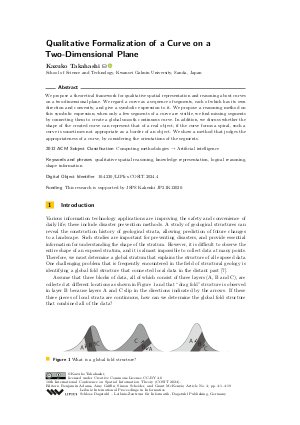Qualitative Formalization of a Curve on a Two-Dimensional Plane
Author
Kazuko Takahashi 
-
Part of:
Volume:
16th International Conference on Spatial Information Theory (COSIT 2024)
Part of: Series: Leibniz International Proceedings in Informatics (LIPIcs)
Part of: Conference: Conference on Spatial Information Theory (COSIT) - License:
 Creative Commons Attribution 4.0 International license
Creative Commons Attribution 4.0 International license
- Publication Date: 2024-09-09
File

PDF
LIPIcs.COSIT.2024.4.pdf
- Filesize: 1.05 MB
- 19 pages
Document Identifiers
Subject Classification
ACM Subject Classification
- Computing methodologies → Artificial intelligence
Keywords
- qualitative spatial reasoning
- knowledge representation
- logical reasoning
- shape information
Metrics
- Access Statistics
-
Total Accesses (updated on a weekly basis)
0PDF Downloads0Metadata Views
Abstract
We propose a theoretical framework for qualitative spatial representation and reasoning about curves on a two-dimensional plane. We regard a curve as a sequence of segments, each of which has its own direction and convexity, and give a symbolic expression to it. We propose a reasoning method on this symbolic expression; when only a few segments of a curve are visible, we find missing segments by connecting them to create a global smooth continuous curve. In addition, we discuss whether the shape of the created curve can represent that of a real object; if the curve forms a spiral, such a curve is sometimes not appropriate as a border of an object. We show a method that judges the appropriateness of a curve, by considering the orientations of the segments.
Cite As Get BibTex
Kazuko Takahashi. Qualitative Formalization of a Curve on a Two-Dimensional Plane. In 16th International Conference on Spatial Information Theory (COSIT 2024). Leibniz International Proceedings in Informatics (LIPIcs), Volume 315, pp. 4:1-4:19, Schloss Dagstuhl – Leibniz-Zentrum für Informatik (2024)
https://doi.org/10.4230/LIPIcs.COSIT.2024.4
BibTex
@InProceedings{takahashi:LIPIcs.COSIT.2024.4,
author = {Takahashi, Kazuko},
title = {{Qualitative Formalization of a Curve on a Two-Dimensional Plane}},
booktitle = {16th International Conference on Spatial Information Theory (COSIT 2024)},
pages = {4:1--4:19},
series = {Leibniz International Proceedings in Informatics (LIPIcs)},
ISBN = {978-3-95977-330-0},
ISSN = {1868-8969},
year = {2024},
volume = {315},
editor = {Adams, Benjamin and Griffin, Amy L. and Scheider, Simon and McKenzie, Grant},
publisher = {Schloss Dagstuhl -- Leibniz-Zentrum f{\"u}r Informatik},
address = {Dagstuhl, Germany},
URL = {https://drops.dagstuhl.de/entities/document/10.4230/LIPIcs.COSIT.2024.4},
URN = {urn:nbn:de:0030-drops-208193},
doi = {10.4230/LIPIcs.COSIT.2024.4},
annote = {Keywords: qualitative spatial reasoning, knowledge representation, logical reasoning, shape information}
}
Author Details
Funding
This research is supported by JSPS Kakenhi JP21K12020.
References
-
Lledó Museros Cabedo, Luis González Abril, Francisco Velasco Morente, and Zoe Falomir. A pragmatic qualitative approach for juxtaposing shapes. Journal of Universal Computer Science, 16(11):1410-1424, 2010.

-
Lledó Museros Cabedo and M. Teresa Escrig. A qualitative theory for shape representation and matching for design. In Proceedings of the Sixteenth Eureopean Conference on Artificial Intelligence, ECAI'2004, pages 858-862, 2004.

-
Juan Chen, Anthony G. Cohn, Dayou Liu, Shengsheng Wang, Jihong Ouyang, and Qiangyuan Yu. A survey of qualitative spatial representations. The Knowledge Engineering Review, 30:106-136, 2013.

-
Anthony G. Cohn and Jochen Renz. Handbook of Knowledge Representation. Elsevier, 2008.

-
Zoe Falomir, Albert Pich, and Vicent Costa. Spatial reasoning about qualitative shape compositions. Annals of Mathematics and Artificial Intelligence, 88(11):589-621, 2020.

-
Antony Galton and Richard Meathrel. Qualitative outline theory. Proceedings of the Sixteenth International Joint Conference on Artificial Intelligence, pages 1061-1066, 1999.

-
Kenichi Kano and Akihiro Murata. Structural Geology (in Japanense). Asakura Publishing Co., Ltd., 1998.

-
Lars Kulik and Max J. Egenhofer. Linearized terrain: languages for silhouette representations. In Spatial Information Theory. Foundations of Geographic Information Science, International Conference, COSIT 2003, pages 118-135, 2003.

-
Michael Leyton. A process-grammar for shape. Artificial Intelligence, 34:213-247, 1988.

-
Gérard Ligozat. Qualitative Spatial and Temporal Reasoning. Wiley, 2011.

-
Reinhard Moratz. Representing relative direction as a binary relation of oriented points. In Proceedings of the 17th Eureopean Conference on Artificial Intelligence, ECAI'2006, pages 407-411, 2006.

-
Till Mossakowski and Reinhard Moratz. Qualitative reasoning about relative direction of oriented points. Artificial Intelligence, 180-181:34-45, 2012.

-
Albert Pich and Zoe Falomir. Logical composition of qualitative shapes applied to solve spatial reasoning tests. Cognitive Systems Research, 52:82-102, 2018.

-
Kiyoji Shiono. Development of geology-oriented logical system (geo-logics): Search for mathematical bases of geological data processing (in japanese). Geoinformatics, 30(4):161-179, 2019.

-
Michael Sioutis and Diedrich Wolter. Qualitative spatial and temporal reasoning: current status and future challenges. In Proceedings of the 30th International Joint Conference on Artificial Intelligence, pages 4594-4601, 2021.

-
Spiros Skiadopoulos and Manolis Koubarakis. Composing cardinal direction relations. Artificial Intelligence, 152(2):143-171, 2004.

-
Yuta Taniuchi and Kazuko Takahashi. Spatial representation and reasoning about fold strata: A qualitative approach. In 15th International Conference, ICAART 2023, Revised Selected Papers, pages 244-266, 2024.

-
Momo Tosue and Kazuko Takahashi. Towards a qualitative reasoning on shape change and object division. In 14th International Conference on Spatial Information Theory (COSIT 2019), pages 7:1-7:15, 2019.

